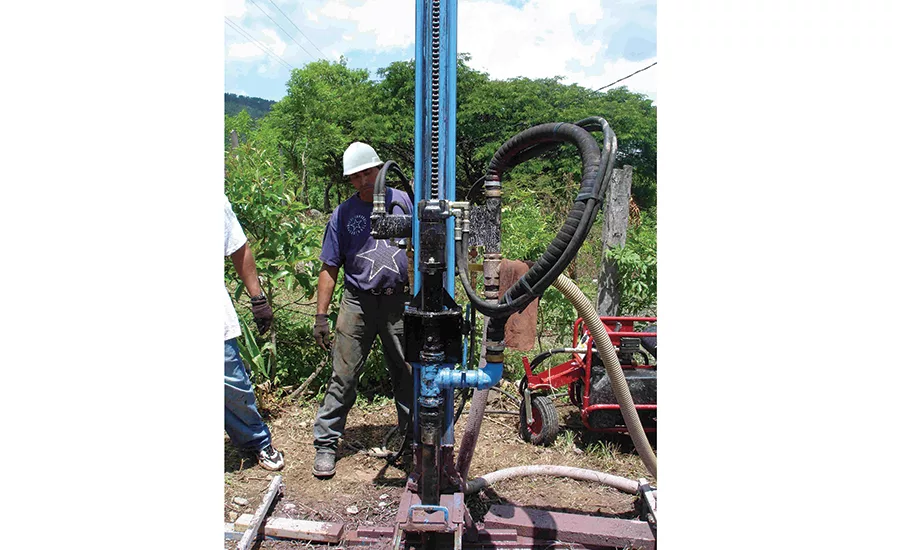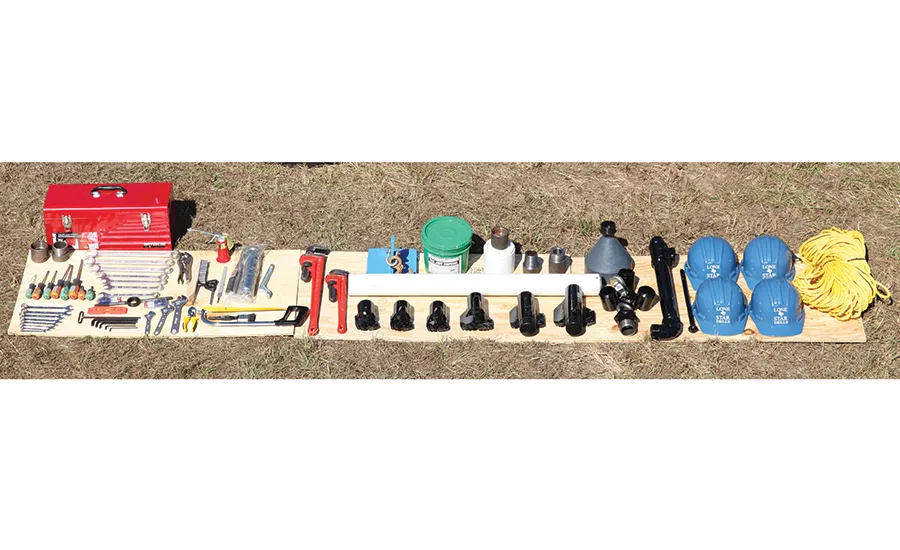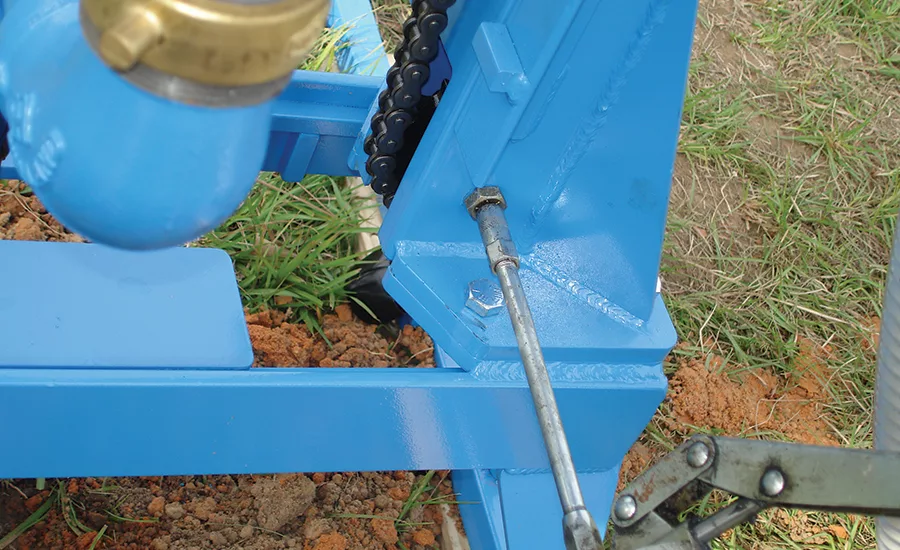For Charity Drilling Jobs, Safety Secures Success

It’s important for operators to know the materials a drill can handle, which minimizes the risk of premature wear and overheating. Source: Lone Star Drills photos

Lone Star Drills’ Missionary Kit contains many of the often used tools and replacement parts a volunteer may need at a remote jobsite. Source: Lone Star Drills photos

Proper maintenance, like regularly hitting the rig with the grease gun, can help reduce unexpected downtime and extend the life of a drill. Source: Lone Star Drills photos
Though we often take clean water for granted, millions around the country are not so lucky, and that daily convenience is replaced by a deep longing for fresh, clean, convenient water. In an effort to help out, volunteers often travel thousands of miles to help locals access clean water in impoverished regions of Africa, the Caribbean, Central America and South America, but traveling to these remote areas, where the equipment and conveniences of home are often impractical and unavailable, can pose safety concerns. The key to success is relying on safety practices and equipment training. This involves knowing how to prepare for the trip, operate the drill correctly and ensure equipment is safe for the next crew.
The planning and preparation begins long before the flight takes off. Before a volunteer’s boots even touch the ground, charity organizations work with villages to determine a safe and convenient well location. This means finding stable ground with low risk of contamination and close access for villagers maintaining the well. While organizations complete this behind-the-scenes work, it’s a perfect time for volunteers to gain knowledge and experience that will make for a safe and successful mission.
Protection Begins with Prepping and Packing
Proper preparation and training go a long way when it comes to maximizing safety on drill sites. Partner with a charity organization and drill manufacturer that offers training videos and safety guides for 24-7 support. Research required immunizations for tropical and subtropical countries, and background on the country’s regulations from the State Department’s Office of American Citizens Services and Crisis Management. This reduces any potential culture shock and helps volunteers feel comfortable once in the field.
In addition, attend pre-departure drill training to become familiar with the different roles on a drill project. For example, volunteers learn how designating a drill team minimizes the risk of injury by reducing confusion about individual responsibilities and how each person on the drill team helps keep the area clear of hazards. The team should include a foreman overseeing the jobsite, lead driller supervising the drilling operation, assistant driller supporting the lead driller and a helper working alongside locals to provide direction and make sure the crew is safe. Training sessions also provide a hands-on opportunity for volunteers to view drilling equipment and learn safe operation procedures. For example, volunteers learn how to check equipment for proper lubrication and how to set up a mud pump.
Before leaving, pack the proper attire and any necessary tools. Bring comfortable clothing, but avoid anything loose that could get caught in moving parts. Pack work boots to properly cover feet and hard hats to protect against head injuries. Sunscreen and a portable canopy can offer protection against blistering sunburns and reduce the risk of heat stroke. Check with manufacturers for any recommended supply packages and a mobilization checklist to ensure that nothing gets left behind.
Save People and Equipment with Open Eyes and Ears
Completing regular equipment maintenance is an essential safety measure because it helps minimize downtime, as well as injuries caused by worn or damaged equipment. Make a daily habit of checking equipment for proper lubrication. This prolongs the life of the drill and keeps the operation running smoothly. Greasing equipment and examining the drive chain provides the drill team an opportunity to look through all of the drill’s major components like the mast, swivel and drawworks. Be sure to reference a torque guide when checking any loose fasteners, nuts or bolts, including the shuttle bolt, rotary head bolt and table base, because they help prevent minor servicing inconveniences from becoming large safety or operational problems.
Prevent safety issues by paying keen attention to the environment and the task at hand. Be alert for any hazards or sounds indicating a potential concern.
Next, rope off the jobsite to ensure bystander safety, and organize tools on dry ground. Place the drill rig in a shaded area, if possible, and always ensure the drill is on stable ground and properly anchored. Anchoring is a must when using compact rotary drills because it stabilizes the drill platform and helps force drill bits through soil and rock. Check to see if the drill manufacturer includes anchoring kits with the drills to shorten setup times.
Once the drill bit starts spinning, there is nothing more important to safety than situational awareness. Prevent safety issues by paying keen attention to the environment and the task at hand. Be alert for any hazards or sounds indicating a potential concern. If the drill starts making an unusual sound, a slapping chain for example, isolate the issue and troubleshoot it using the operators’ manual. If the drill manufacturer included a service kit featuring common wear parts and tools, repairing issues is quick. If there isn’t a solution in the operators’ manual, the best troubleshooting is having a drill manufacturer that offers around-the-clock technical support, answering any questions an operator might have or shipping a replacement part. In the long run, being cautious protects the drill team, the drill’s service life and the overall success of the mission.
Know what materials the drill can handle to minimize the risk of prematurely wearing or overheating the drill, which can create safety concerns if it’s not monitored. Drill teams might use a mechanical rotary drill to bore shallow wells — as deep as 200 feet — in cohesive and granular soils.
Hydraulic drills reach depths of 200 to 400 feet in sand, clay and rock because of their large drill platform and heavy weight. Some compact, trailer-mounted hydraulic rotary drills weigh 7,700 pounds, giving them powerful downforces for drilling through challenging soil. These drills might feature a bypass control that allows operators to tailor the downforce to fit their needs. This contributes to a safe drilling process by making powerful equipment easily manageable for different operators. A release lever is another safety feature on some hydraulic models that allows the operator to safely react to changing conditions without risking a borehole collapse. If a volunteer starts showing symptoms of heat stroke, for instance, the operator can let go of the release lever, causing the drive head to cease upward or downward movement immediately, so he or she can help the volunteer. And the drive head will continue rotating after the operator releases the lever to prevent borehole cuttings from settling around the drill pipe or the borehole from collapsing.
Lastly, when working with hydraulic drills it’s important to never use hands to search for hydraulic oil leaks as the force of pressurized hydraulic oil escaping from couplings and hoses can penetrate skin. Instead, use a piece of cardboard or wood.
As a final safety tip throughout the project, keep a careful watch over the borehole or cover it with a piece of plywood or bucket when taking a break. The borehole is open throughout the drilling process, meaning it needs constant guarding. While pipe will cover a portion of the borehole, tools or parts could easily slip between the pipe and the wall of the borehole. In the best-case scenario, the operator would stop the machine and remove the object. But more times than not, it is impossible to pull objects out. Then, the entire process would have to start over in a different location, increasing the chance of a safety issue occurring, and the old borehole must be backfilled and capped to prevent injuries.
After drilling is complete, don’t be hasty turning in for the day. Cleaning the drill site and equipment is an essential safety practice.
Not So Fast — Commit to Cleaning Before Completion
Properly caring for equipment and cleaning the drill site after a project’s completion saves tremendous amounts of time and ensures a safe start for the next drill team. Rust, for example, is both a maintenance and safety issue because it increases the risk of contracting tetanus and other infections, as well as decreases the service life of drilling equipment, which is why volunteers should follow recommended cleanup procedures. Wash muddy drill pipe to avoid slippery handling and prevent rust. Replace the thread protector caps before storing pipe on a trailer. Flush the mud pump and hoses with clean water. Remove soil and coat drill bits with oil before storing to minimize corrosion. Clear box threads of dirt and grease with a wire brush. Any potential hazards, such as drilling debris, should be removed from the area to avoid injury.
Keep the drill site roped off until completion of well development practices, such as cleaning out clay and silt. This prevents bystanders from wandering and potentially injuring themselves on equipment, or stepping into the borehole. Once the water is clear and all safety standards are met, pour concrete around the well and install a hand pump. Following these procedures ensures villagers receive safe and quality water.
A successful project is one that achieves its goal without causing injury to those involved. Proper preparation, situational awareness, and routine cleaning and maintenance are the foundation to an impactful mission. Return home knowing a commitment to safety brought clean water to those who need it most.
Looking for a reprint of this article?
From high-res PDFs to custom plaques, order your copy today!



